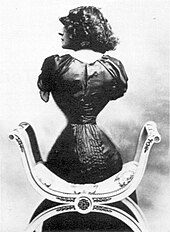History
In the 19th century, while average corseted waist measurements varied between 23 and 31 inches (58 and 79 cm), wasp waist measurements of 16 to 18 inches (41 to 46 cm) were uncommon and were not considered attractive. Ladies' magazines told of the side effects of tight lacing, proclaiming that "if a lady binds and girds herself in, until she be only twenty-three inches, and, in some cases, until she be only twenty-one inches, it must be done at the expense of comfort, health, and happiness." [1] Fashions instead created the illusion of a small waist, using proportion, stripe placement, and color. Retouching photographs was sometimes used to create the illusion of a wasp waist. [2]
Extreme tight lacing (15–18 in or 38–46 cm) was a fad during the late 1870s and 1880s, ending in around 1887. [3] [4]
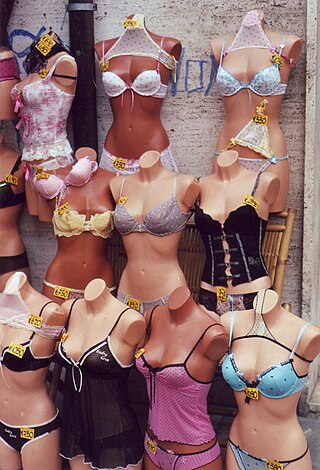
Lingerie is a category of primarily women's clothing including undergarments, sleepwear, and lightweight robes. The choice of the word is often motivated by an intention to imply that the garments are alluring, fashionable, or both. In a 2015 US survey, 75% of women reported having worn "sexy lingerie" in their lifetime.
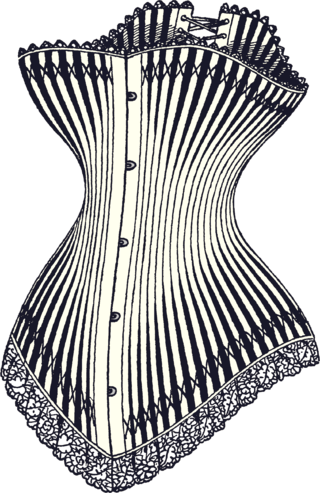
A corset is a support undergarment worn to hold and train the torso into the desired shape and posture. They are traditionally constructed out of fabric with boning made of whalebone or steel, a stiff panel in the front called a busk which holds the torso rigidly upright, and some form of lacing which allows the garment to be tightened. Corsets were an essential undergarment in European women's fashion from the 17th century to the early 20th century. In the 17th and 18th centuries they were commonly known as "stays" and had a more conical shape. This later evolved into the curvaceous 19th century form which is commonly associated with the corset today. By the beginning of the 20th century, shifting gender roles and the onsets of World War I and II led the corset to be largely discarded by mainstream fashion.
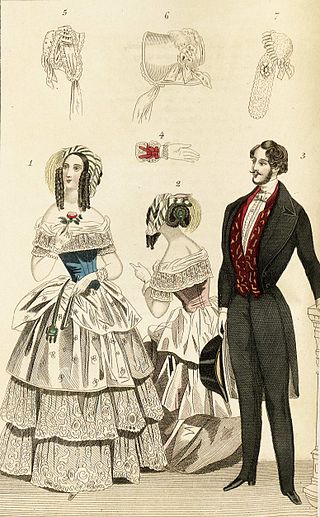
Victorian fashion consists of the various fashions and trends in British culture that emerged and developed in the United Kingdom and the British Empire throughout the Victorian era, roughly from the 1830s through the 1890s. The period saw many changes in fashion, including changes in styles, fashion technology and the methods of distribution. Various movement in architecture, literature, and the decorative and visual arts as well as a changing perception of gender roles also influenced fashion.

Tightlacing is the practice of wearing an increasingly tightly laced corset to achieve cosmetic modifications to the figure and posture or to experience the sensation of bodily restriction. The process originates in mid-19th century Europe and was highly controversial. At the peak of the prevalence of tightlacing, there was much public backlash both from medical doctors and dress reformers, and it was often ridiculed as vain by the general public. Due to a combination of evolving fashion trends, social change regarding the roles of women, and material shortages brought on by World War I and II, tightlacing, and corsets in general, fell out of favor entirely by the early 20th century.

The waist is the part of the abdomen between the rib cage and hips. Normally, the waist is the narrowest part of the torso.
A training corset is generally a corset used in body modification. A training corset is believed to help orthopedic issues and it is believed to help cosmetic issues

A corsetmaker is a specialist tailor who makes corsets. Corsetmakers are frequently known by the French equivalent terms corsetier (male) and corsetière (female). Staymaker is an obsolete name for a corsetmaker.
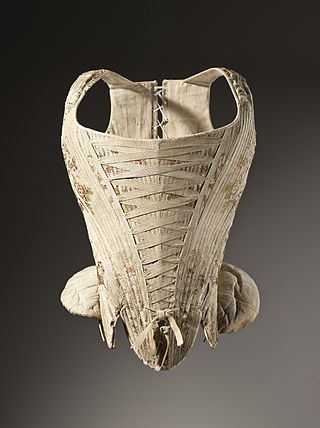
The corset is a supportive undergarment for women, dating, in Europe, back several centuries, evolving as fashion trends have changed and being known, depending on era and geography, as a pair of bodies, stays and corsets. The appearance of the garment represented a change from people wearing clothes to fit their bodies to changing the shape of their bodies to support and fit their fashionable clothing.

Fashion in the 1890s in Western countries is characterized by long elegant lines, tall collars, and the rise of sportswear. It was an era of great dress reforms led by the invention of the drop-frame safety bicycle, which allowed women the opportunity to ride bicycles more comfortably, and therefore, created the need for appropriate clothing.

A foundation garment is an undergarment designed to impermanently alter the wearer's body shape, to achieve what some view as a more fashionable figure. The function of a foundation garment is not to enhance a bodily feature but to make it look more presentable.

An hourglass corset is a garment that produces a silhouette resembling an hourglass shape characterized by wide hips, narrow waist, and wide bust.

The hourglass figure is one of four traditional female body shapes described by the fashion industry. The other shapes are the rectangular, inverted triangle, and spoon/pear. The hourglass shape is defined by a woman's body measurements- the circumference of the bust, waist and hips. Hourglass body shapes have a wide bust, a narrow waist, and wide hips with a similar measurement to that of the bust. This body shape is named for its resemblance to that of an hourglass where the upper and lower half are wide and roughly equal while the middle is narrow in circumference, making the overall shape wide-narrow-wide. Women who exhibit the hourglass figure have been shown to be more admired, which can put pressure on women whose body shapes are noticeably different to strive to achieve the hourglass figure. This can lead to body dissatisfaction which can cause eating disorders in young women from all over the globe.
Rib removal is surgery to remove one or more ribs. Rib resection is the removal of part of a rib. The procedures are done for various medical reasons. A number of celebrities have been falsely rumoured to have had ribs removed as a form of body modification.

A basque is an item of women's clothing. The term, of French origin, originally referred to types of bodice or jacket with long tails, and in later usage a long corset, characterized by a close, contoured fit and extending past the waistline over the hips. It is so called because the original French fashion for long women's jackets was adopted from Basque traditional dress. In contemporary usage it refers only to a long item of lingerie, in effect a brassiere that continues down, stopping around the waist or the top of the hips, the lower part essentially decorative rather than providing support or indeed warmth.

Metal corsets are a type of historical corset or bodice made entirely out of metal, usually iron or steel. The metal corset was popularly claimed to have been introduced to France by Catherine de' Medici in the 16th century, although this is now considered a myth. The idea that such garments were worn for fashionable purposes is debatable, with fashion historians now regarding such claims sceptically. Many of the original metal bodices that have survived are now believed to have been intended for medical purposes as orthopaedic support garments and back braces. Such garments were described by the French army surgeon Ambroise Paré in the 16th century as a remedy for the "crookednesse of the Bodie."

Underwear, underclothing, or undergarments are items of clothing worn beneath outer clothes, usually in direct contact with the skin, although they may comprise more than a single layer. They serve to keep outer clothing from being soiled or damaged by bodily excretions, to lessen the friction of outerwear against the skin, to shape the body, and to provide concealment or support for parts of it. In cold weather, long underwear is sometimes worn to provide additional warmth. Special types of undergarments have religious significance. Some items of clothing are designed as undergarments, while others, such as T-shirts and certain types of shorts, are appropriate both as underwear and outerwear. If made of suitable material or textile, some underwear can serve as nightwear or swimwear, and some undergarments are intended for sexual attraction or visual appeal.

Female body shape or female figure is the cumulative product of a woman's bone structure along with the distribution of muscle and fat on the body.

The corset controversy was a moral panic and public health concern around corsets in the 19th century.

A waist cincher is a belt worn around the waist to make the wearer's waist physically smaller, or to create the illusion of being smaller.
Mr. Pearl is a noted corsetmaker of the late 20th and early 21st century. Pearl is known for his work with designers such as Vivienne Westwood, and has designed corsets for celebrities such as Kylie Minogue and Dita Von Teese.
